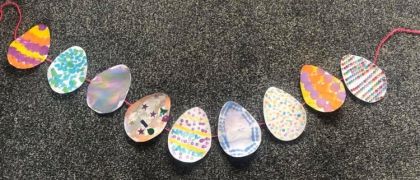
Blog
Easter wreaths and bunting
During this sunny Easter weekend our Mayflower team in Billericay have been busy thinking of some lovely ways to decorate our houses to make everyone smile.
Here's an activity for you all to try. Have fun!!!
Resources you may need:
- White paper/card
- Paint, glue,
- Colouring pencils, pens, or crayons
- Pom poms/cotton wool balls, pegs
- Tissue paper/coloured paper
- Scissors
- Lego bricks, shaped bricks
- Straws/cotton buds, sticks
- Egg template
This activity can be adapted for all ages. The children will have great fun exploring with colour, textures and discovering different ways to make marks. I have provided a resource guide for you but feel free to get creative and ask your child what other objects they can find around the house/garden too.
How to make your Easter wreath/bunting
Firstly, you will need some white card or paper to draw/print your egg shape template on. You will need at least 10 for both activities.
If making a wreath you will need a large circle to draw round, then a smaller circle for the inside. Then cut the inner circle out, you could also use a paper plate if you have one.
Then cut the egg shapes out ready for your child to get creating. Let your child choose their own pattern and allow them to express themselves when decorating the eggs. Here's some ideas to get them started:
- Using the pegs and pom poms/ cotton wool balls
- Straws, cotton buds or sticks to make lines in the paint or mix colours
- Collage sticking with paper cuttings
- Colouring a pattern
- Paint with Lego or shaped bricks.
When they have dried glue the egg shapes around your wreath and attach ribbon, wool or string and find somewhere to hang your creation.
For the bunting use sticky tape and wool to attach the eggs and then display your bunting in a window or a door for all to see.
Early Learning goals
This activity can be linked to all areas of the EYFS
Personal, social and emotional: Exploring independently and expressing their preferences and interests.
Communication and language: Encouraging children to share their ideas, talk about what the marks they have made. Also having a strong exploratory impulse.
Physical development: Developing scissor control, drawing lines and circles, and making connections between the marks they have made.
Maths: Showing an interest in shapes and incorporating counting objects.
Literacy: Listening to music while creating, giving meaning to the marks they make.
Understanding the world: Looking at differences, changes and talking about similarities. Collecting natural objects to create with.
Expressive arts and design: Experimenting with colour, blocks and marks, and using tools for a purpose.
